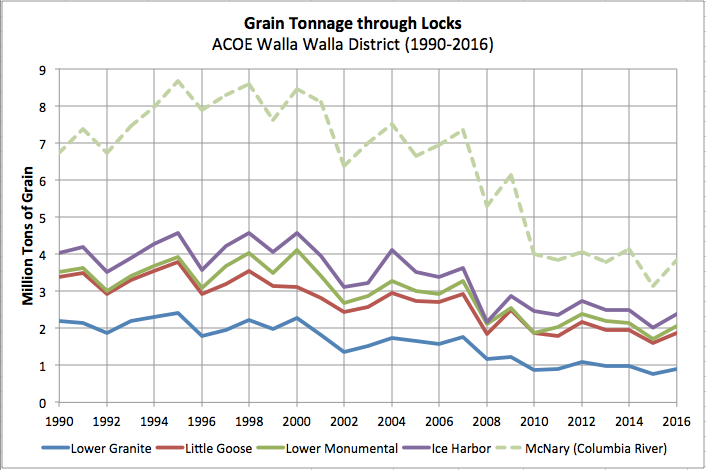forum
library
tutorial
contact

Washington State Bolsters Support for
Salmon Recovery in Columbia Basin
by Sharon Udasin
The Hill, December 5, 2024
|
the film forum library tutorial contact |

|
Washington State Bolsters Support for
by Sharon Udasin
|
"We cannot waver for a moment, now or in the future, in our work to restore these runs."
-- Washington Gov. Jay Inslee
 Washington Gov. Jay Inslee (D) has directed state agencies to take immediate actions aimed at safeguarding the region's dwindling salmon population, while warning the incoming Trump administration to refrain from backtracking on federal commitments.
Washington Gov. Jay Inslee (D) has directed state agencies to take immediate actions aimed at safeguarding the region's dwindling salmon population, while warning the incoming Trump administration to refrain from backtracking on federal commitments.
In an executive order signed this week, Inslee asked state officials and organizations to strengthen their work on restoring the Columbia River Basin's salmon population, advance science-based solutions, revive habitats and bring together diverse interest groups.
"Salmon have inhabited Washington for millions of years, but their time is running out," Inslee said in a statement. "We cannot waver for a moment, now or in the future, in our work to restore these runs."
The order emphasizes the state of Washington's commitment to collaborating with other stakeholders, referencing a December 2023 partnership with Oregon and the Confederated Tribes and Bands of the Yakama Nation, the Confederated Tribes of the Umatilla Indian Reservation, the Nez Perce Tribe and the Confederated Tribes of the Warm Springs -- collectively known as the "Six Sovereigns."
At the time, the multistate and tribal parties agreed to a comprehensive package of actions called the Columbia Basin Restoration Initiative to address the salmon and steelhead decline, as well as climate, energy and tribal justice issues challenging the region.
In parallel, the federal government also committed to restoring populations of Columbia and Snake River salmon and steelhead through a stay of litigation with the Six Sovereigns.
Specifically, the Biden administration directed federal agencies to prioritize the restoration of these species and other native fish populations, estimating that these efforts would bring more than $1 billion in new federal investments to the region.
Fulfilling both the Columbia Basin Restoration Initiative and federal goals could help bolster the state of Washington's broader decarbonization and climate goals, while also honoring tribal treaties, resolving ongoing lawsuits and enhancing watershed resilience, according to the order.
"It is my administration's policy to take full advantage of this unique moment in time and unprecedented window of opportunity through coordinated state leadership," Inslee wrote in the order. Inslee, a three-term governor and ardent critic of President-elect Trump, decided last year not to run for a fourth term and will leave office in January.
He stressed in the order that he would be supporting not only collaborative restoration efforts across the state, but also the "full implementation" of federal commitments.
 "These fish and these waters are our responsibility to defend," Inslee said in a statement. "We've charted a course for salmon recovery, and this order holds us to it."
"These fish and these waters are our responsibility to defend," Inslee said in a statement. "We've charted a course for salmon recovery, and this order holds us to it."
Following the issuance of the executive order, the organization Earthjustice -- which has headed longstanding litigative efforts to protect the Columbia River Basin -- praised the governor's decision to move forward.
"We applaud Gov. Inslee for his exemplary leadership to restore the Pacific Northwest's native fisheries to healthy and abundant levels, while also helping Washington transition to a clean, affordable, and resilient energy future," Earthjustice attorney Amanda Goodin said in a statement.
Abby Tinsley, vice president for conservation policy for the National Wildlife Federation, touted the order as "a critical step that builds the momentum needed to save the region's renowned salmon runs from extinction, and -- of paramount importance -- make good on commitments to Northwest Tribes."
In an explainer issued alongside the executive order, the governor's office provided words of warning to the incoming Trump administration, stressing that if the federal government backs away from its commitments, it will face "a salvo of litigation for breach of Tribal treaty rights affirmed by precedent."
"We need to think of our state and its waters as borrowed rather than inherited," Inslee said. "We owe future generations a healthy state."
Related Sites:
Experimental Drawdown Study, Lower Granite Reservoir, North-Central Idaho, March 1992 by R.W. Harper and S.W. Lipscomb, U.S. Geological Survey in Cooperation with U.S. Army Corps of Engineers, 1994
Related Pages:
Ag to Inslee: 'Assert True Leadership' on Dams by Matthew Weaver, Capital Press, 12/16/23
EXECUTIVE ORDER 24-06
SALMON RECOVERY:
RIPARIAN PROTECTION AND RESTORATION AND
ADVANCING THE COLUMBIA BASIN RESTORATION INITIATIVE AND
AGREEMENT. . .
16. Complete, as soon as possible, the replacement needs studies for energy, water, transportation, and recreation, as described in the RCBA and called for in the 2022 Murray/Inslee Lower Snake River Dams: Benefit Replacement Report, for understanding and securing continuity of services provided by the Lower Snake River Dams ("LSRDs") should Congress decide to authorize removal of the LSRDs.
17. In partnership with the Six Sovereigns and USG, work to inform and expand support for the CBRI and RCBA among other regional sovereigns and stakeholders. Incorporate appropriate input from the below collaborations with Washington sectors into broader regional collaborations associated with the CBRI and RCBA, including the Pacific Northwest Regional Energy Planning Project process.
Provisions of this Executive Order are not intended to alter any existing collective bargaining agreements. This Order is not intended to confer and does not confer any legal right or entitlement and shall not be used as a basis for legal challenges to any rule or any other action or inaction of the governmental entities and employees subject to it.
- For Washington's energy, transportation, agriculture, water and recreation sectors potentially impacted by Lower Snake River restoration associated with the CBRI and RCBA, seek input and collaboration from these sectors to help ensure efforts moving forward are consistent with the CBRI objectives to:
- Ensure continuity of services provided by the LSRDs are secured prior to dam breaching;
- Ensure investments to secure those LSRD services minimize additional rate pressures and financial burdens on these sectors, relative to likely pressures and burdens without Lower Snake River restoration;
- Ensure direct costs of actual Lower Snake River restoration are not disproportionately borne by any single sector;
- Ensure advancing the CBRI and RCBA are complementary to, and help leverage resources toward, an equitable clean energy transition and a resilient and affordable energy system, as well as statewide efforts to modernize and enhance transportation, water and climate security.
- For Washington fishery, tourism and economic development sectors, seek input and collaboration regarding opportunities associated with restored fish runs, healthy watersheds, and enhanced resilience and adaptation to climate change associated with advancing the CBRI and RCBA.
Effective date: This Executive Order shall take effect immediately.
Expiration: This Executive Order will be reconsidered at the end of the 10-year litigation stay, or at the time a non-federal party withdraws from the Memorandum of Understanding agreement between the Six Sovereigns and the US Government, and/or the RCBA is terminated. The duration of this Executive Order is to be guided by its intent to recover salmon habitat statewide and to promote full implementation of the CBRI until salmon and steelhead are restored to healthy and abundant numbers.
Signed and sealed with the official seal of the state of Washington, on this 3rd day of December, Two Thousand and Twenty-Four, AD, at Olympia, Washington.
learn more on topics covered in the film
see the video
read the script
learn the songs
discussion forum
